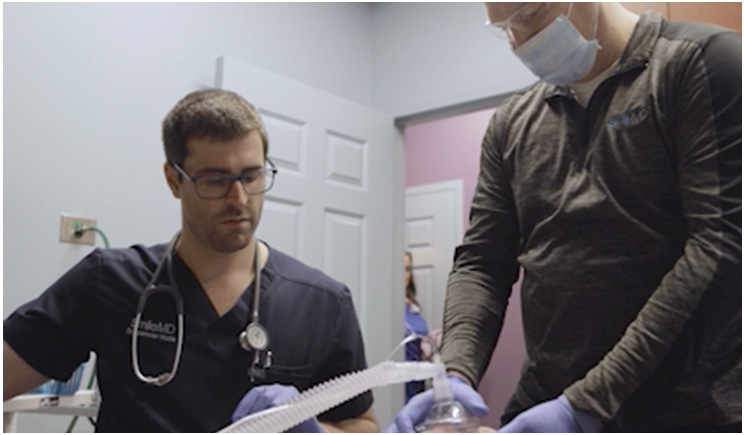
Like many of my colleagues, I specialized in dental anesthesiology to be able to help those whose oral health would be neglected without pharmacologic assistance.
Using mobile anesthesia allows me to offer a hospital-grade experience in local dental offices, which not only creates a more convenient and efficient experience for everyone involved, but also allows me to provide my services to anxious patients in a setting that works for them. I am able to provide a safe and comfortable experience at every level, from the preoperative assessment through sedation and recovery.
Anxiety & Sedation
Anxiety comes in many forms. Early negative experiences often lead to dental anxiety over time. Sometimes, it’s severe enough to be defined as PTSD. Other times, underlying anxiety or depression becomes heightened by unfamiliar or stressful situations like a dental office or procedure.
For pediatric patients, the anxiety is usually transposed onto the child from the parent. Maybe the child has only seen a dentist a few times and has no reason for fear. But the parents, usually out of good intentions to prepare their child, will emphasize the needle, or the tools the surgeon will use, or how there’s nothing to be afraid of, which can ironically though not surprisingly lead to a sense of fear.
In my practice, anxious patients are referred to me by the dentist after different levels of sedation and alternative treatment modalities are discussed. My team and I will then review the health history and other relevant information to make sure the case is appropriate prior to scheduling. Some patients prefer a more mild experience with oral sedation or moderate sedation, and other patients or practitioners prefer general anesthesia for their specific needs.
There are certain procedures that nearly all patients would prefer to be sedated for whether they struggle with anxiety or not. That includes many procedures an oral surgeon would need to do, such as impacted teeth, orthognathics, or facial injury repairs. And then there are some procedures in which a non-anxious patient might be comfortable being awake for that anxious patients would need to be sedated for, such as crowns, fillings, root canals, or even tooth extractions.
Serving Anxious Patients in Local Dental Offices
I work with SmileMD, a mobile sedation company that connects me to the dental offices that want to keep their patients and operations in-house. Through this route, I am able to tailor the anesthetic plan to the needs of a specific patient and dentist, because I am embedding myself into their environment. The convenience of keeping a patient in-house also will greatly benefit the patient as it will allow them to continue care in a known environment.
Pediatric patients are usually sent to the hospital under normal circumstances. In some cases, a dental office might need to refer 20 to 30 pediatric patients a week to a hospital for a procedure, where they’re vying for operating space with hundreds of other patients needing care. In many cases, we see a wait of at least six months to be seen in a pediatric hospital.
Keeping a child in pain and discomfort for that long can hurt their social skills, disrupt their sleep and education, and harm their ability to get the nutrition they need. This isn’t isolated to pediatric care either. Forcing adults to wait for procedures can have many of the same effects.
When going to the hospital, there’s also the concern of travel time and unfamiliarity. In Southeast Ohio, a region near where I work, there is just one dental office in a vast radius that serves patients from as far away as Kentucky and West Virginia. If they aren’t able to have a procedure done at that office, they have to travel hours for the nearest pediatric hospital while being on a waitlist for months. It makes for a long day and a daunting experience for patients and parents. In-house procedures, and companies like SmileMD that make them easier, are creating much better experiences with more positive patient outcomes.
More important than convenience are patient safety and satisfaction. The team-based approach that I use consisting of a paramedic, an anesthesiologist, and a recovery nurse is centered around patient safety. The plan is tailored to the specific patient we’re treating, and we can be confident that we’re giving the patient the outcome they want—a safe procedure, a comfortable environment, and a resolution to their dental issue.
When I work with patients like this, my immediate goal is to do what I can to reduce or eliminate their anxiety. And while I have the tools and medications to do that through sedation, it also comes from listening to each patient and validating their unique experiences, especially when they come to me with a story about a bad dental office experience.
I’ll never tell them they’re overreacting. I will affirm what they experienced and are feeling, and then I will tell them that my goal is to give them a more pleasant experience with this appointment. The sedation does help for that day, but my goal also is to provide a positive comprehensive experience and help reverse some of the negative connotations they have about the dentist.
Dr. Wade received his BS from the University of Michigan in 2012 and his DDS from the Ohio State University in 2016. He then conducted his dental anesthesiology residency with the Ohio State University Medical Center. He practices dentistry in Dublin, Ohio, and has been working with SmileMD since 2019. SmileMD is a mobile anesthesia services company founded by anesthesiologists. It provides anesthesia to pediatric and adult dental patients in office settings, increasing access to care for thousands of patients each year.
Related Articles
Mobile Anesthesia Providers Can Help Dental Practices Rebound from the Pandemic
What Is a Dentist Anesthesiologist?
Dental Anesthesiology Finally Gets the Recognition It Deserves











